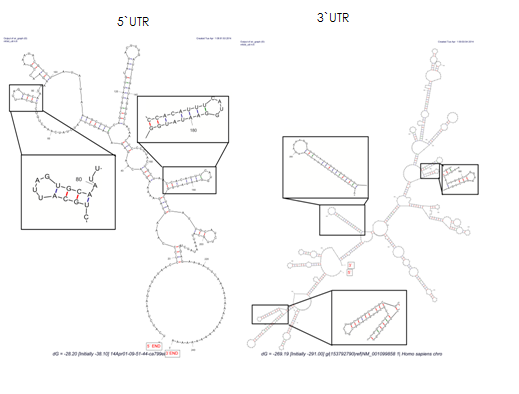| Reference | Detailed Family Information | Start (nucleotide) | End (nucleotide) | Strand |
|---|
| XCPE | Activator-, mediator- and TBP-dependent core promoter element for RNA polymerase II transcription from TATA-less promoters | 360 | 370 | - |
| MIZ1 | Myc-interacting Zn finger protein 1 | 120 | 130 | - |
| PLAG1 | Pleomorphic adenoma gene | 160 | 182 | - |
| FOX proteins | Fork head domain factors | 35 | 51 | + |
| E2FF | E2F-myc activator/cell cycle regulator | 357 | 373 | - |
| MZF1 | Myeloid zinc finger 1 factors | 497 | 507 | + |
| HAND | Twist subfamily of class B bHLH transcription factors | 335 | 355 | - |
| RU49 | Zinc finger transcription factor RU49, zinc finger proliferation 1 - Zipro1 | 651 | 657 | - |
| NF-κB | Nuclear factor kappa B/c-rel | 219 | 233 | - |
| E2FF | E2F-myc activator/cell cycle regulator | 492 | 508 | + |
| SP1F | GC-Box factors SP1/GC | 490 | 506 | + |
| IKRS | Ikaros zinc finger family | 64 | 76 | + |
| STAT1 | Signal transducer and activator of transcription | 409 | 427 | - |
| RBP2 | Retinoblastoma-binding proteins with demethylase activity | 538 | 546 | - |
| YY1F | Activator/repressor binding to transcription initiation site | 553 | 575 | - |
| SP1F | GC-Box factors SP1/GC | 359 | 375 | - |
| HSF | Heat shock factors | 240 | 264 | - |
| BPTF | Bromodomain and PHD domain transcription factors | 423 | 433 | + |
| ZNF35 | Zinc finger protein ZNF35 | 309 | 321 | + |
| ETSF | Human and murine ETS1 factors | 235 | 255 | + |






